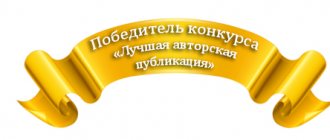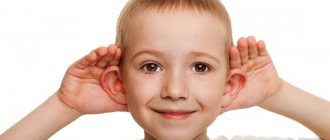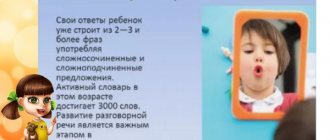Features of speech development of older preschoolers
A child of 5-7 years old monitors the pronunciation features of his peers and some errors in his own speech, and masters the sound analysis of words. It is not immediately possible without errors: sibilants are not pronounced clearly, in complex words syllables are rearranged, the letter “P” is not pronounced. A kindergartener's number of simple, common and complex sentences increases. Errors occur when changing words by case, especially when forming nouns in the genitive plural (“no gloves”). Teachers guide children in the correct use of grammatical forms. To understand how nouns are formed, let’s introduce children to the concept of a word-formation pair; Let's tell you how, with the help of the same suffix, words are formed that indicate a person (work-worker, gardener-gardener) or an object (rain-raincoat).
At this age, the child retells fairy tales or short stories, and comes up with a plot based on a series of paintings. Children are able to identify a topic and arrange parts of a text sequentially. With the help of adults, he selects words with the same root. The children form and use comparative adjectives in speech (strong - stronger; bright - brighter). They correctly understand and use prepositions without errors. Having heard an unfamiliar word, preschoolers often change it into one that is known. Mistakes occur, this is due to the identity of the roots: robber-rake.
Some children do not know how to use intonation or monitor the speed and volume of speech. In the senior group of kindergarten, a new type of work is introduced: children are introduced to the verbal composition of a sentence. Working on the intonation and expressiveness of speech will also help: we teach children to express their attitude to what is happening with their voice (raising and lowering their voices, placing logical stresses).
FEMP in the preparatory group for preschoolers
Dialogical speech is important for a child: he lives in society. Teachers are working to improve it. Here we include:
- Ability to listen and understand the interlocutor;
- Formulate questions;
- Build a replica based on the task at hand;
- Use the norms of speech etiquette (greetings, farewells).
Instill in children the ability to build a dialogue: ask, support, thank, answer, ask for forgiveness.
To do this, conversations are held on various topics that are related to life in the family and in kindergarten. The baby learns to listen to the interlocutor and ask questions. The skills that a child acquires during the construction of dialogic speech will also be useful in monologue. Parents often devote themselves to everyday work without reserve, so they do not pay due attention to the child’s speech development. The preschooler has a poor vocabulary.
Close cooperation between family and kindergarten is the path to correct speech and a rich vocabulary. It is important that you talk to your child at home: read books aloud, discuss the events of the day.
Child's speech and thinking
§ 6. Adapted information
The criterion for adapted information in relation to the pseudo-information that makes up the collective monologue is the result obtained: the child manages to force the interlocutor to listen to himself and influence him, that is, to tell him something.
So, the child speaks here, applying himself to the point of view of the interlocutor. The function of speech for the speaker is no longer to motivate himself to activity, but to communicate a thought. These are difficult criteria to define; we will try to find more accurate ones.
It is tailored information that generates dialogues. Children's dialogues deserve in-depth study, since both the awareness of logical rules and the form of deductive reasoning probably depend on the habits acquired in an argument (as Baldwin and Janet emphasized). We will therefore try in the next chapter to outline the stages through which conversation among children passes. For now, we will be content with characterizing the adapted information (whether it will be in the form of dialogue or not) in relation to the entire set of statements of our two subjects and establishing the small role that this form of speech plays in comparison with egocentric forms and socialized forms without statements (orders, threats, criticism, etc.).
The first type where adapted thought exchange appears is a simple message. Here are some striking examples:
Lev helps Geo play lotto: “ This is here, I think
"
Geo shows a second cardboard of the same kind. Leo: “ If you lose one, then there will be one left
.”
Then: “ You have three of the same
” or “
You see how to do it
.”
The teacher L. calls Ara: “Roger.” Pi: “ His name is not Roger
».
It is clear that such statements differ significantly from a monologue together. Here the child wants to communicate something to the interlocutor. He speaks not from the latter’s point of view, but from his own. As a result, the child tries to be understood and insists on his own if he does not achieve the goal, while in a collective monologue he is indifferent to where the thrown word ends up.
Of course, within the framework of adapted information, a child can talk about himself in the same way as about any thing. It is enough that his statements are adapted, as in the following two examples:
Ez and Pi. " I'll have one tomorrow
[tram subscription].
“ I’ll have it this afternoon
.”
Ez and Pi build a church together from blocks: “ We can make parallels from this
. —
I want to draw parallels
».
Now we can clarify the criteria that will distinguish a collective monologue from adapted information. A collective monologue occurs whenever the child talks about himself, with the exception of those cases when the child talks about himself while working together with an interlocutor (as in the previous example of building a church) and with the exception of dialogues. We assume that dialogue will take place when the interlocutor responds to a sentence by talking about the subject in question in that sentence (as in the previous example about a tram subscription), without talking nonsense, as in a collective monologue [8].
So, adapted information occurs whenever the child tells the interlocutor about something other than himself, or when he, speaking about himself, initiates cooperation or simply dialogue; but while the child is talking about himself, without cooperating with the interlocutor and without starting a dialogue, we have a collective monologue.
These definitions and the unsuccessful attempts to involve others in the actions of the speaker through a collective monologue make it even more surprising that Pi and Lev have half the number of statements in the form of adapted information as collective monologues.
Now we will see this in exact numbers. Let us first find out what both of our subjects inform each other about and how they argue in those rare cases when we can talk about children’s disputes.
Regarding the first of these points, it should be noted that there is no explanation between the children, in the proper sense of the word, if we understand by explanation a causal explanation - one that answers the question “why” in the sense of “for what reason” or “on what basis.”
All noted cases of messages that could resemble explanations are static, that is, descriptive and alien to the desire to state the cause of phenomena.
Here are examples of these static, or descriptive, messages:
Lev and Pi: " It's 420
";
" No.
10 hours ";
“ The roof is not like that
[talking about the drawing]”, “
This is a village, a big village
”, etc.
Even when children talk to each other about natural phenomena, their mutual messages do not concern causality:
A lion. “Thunder, it's rolling. - No, it doesn't roll.
- This is water.
- But no, it doesn't roll.
- Thunder, what is this?
“ Thunder is
... [doesn’t finish].”
This lack of causal explanations should be especially noted when it comes to cars, automobiles, bicycles, etc., which children sometimes talk about among themselves, but always from the same static perspective:
A lion. " This is the same rail
";
" Funny carriage, car
";
" A bicycle for two people
."
But each of the children individually is able to explain the mechanism of a bicycle: Pi - satisfactorily, and Lev - very well. Each of them has many ideas about mechanics, but they do not talk about them among themselves. Causal connections remain unspoken, and everyone thinks about them to himself, probably because the child thinks of them more in images than in words. Only the static essence is expressed through words.
This property is especially striking when it comes to the cooperation of children in a common game.
For example, Pi and Ez are busy drawing a house together.
Pi. “ There you need a button for the light, you need a button for the light...
";
“ Then I’ll do ettricism...
”;
“ Two ethicities, look.
There will be two ethicities. All the sites there are ethic .”
Subsequently, we will see some confirmation of the hypothesis according to which the causal “why” is not at all the object of children’s conversation. In particular, in Chapter III we will see that the explanations evoked by the child in a child from 6 to 8 years old are poorly understood as far as the relation of causality is concerned. So questions of causation persist in conversations between children and adults, or between young and old. In other words, for children, most of these questions remain in the area of intimate and unformulated reflection.
These are those of the reasoning of a child with a child, noted by us in Lev and Pi, which most closely resemble a causal explanation; they remain almost exclusively descriptive:
A lion. “ We need some water. It is very hard, green paint, very hard...
». «
Made from cardboard, don't you know? You know how to do it, but it's a little difficult for you, for everyone
».
Regarding the nature of disputes between children, it is remarkable that here there is complete correspondence with the described phenomenon: just as our two subjects do not communicate to each other their thoughts regarding the cause and basis of phenomena, in the same way they do not motivate their statements in the dispute through logical “ because" or "since".
Their dispute, with only two exceptions, consists of a simple clash of statements without logical justification. It belongs to the type that in our work on the stages of conversation between children (see the next chapter) we will call “primitive argument” and characterize it precisely by the lack of motivation.
The example just given (the debate between Leo and a child of the same age about thunder) proves this very clearly. Here are three other examples, the first two are very clear, the third is intermediate:
Pi. “[Ez says to Pi:] You will marry me. - I won't marry you.
- No, you will marry me.
- No.
- Yes...”, etc.
A lion. “Look what a nice 6 I will have.” - Yes, it’s a 6, but, in truth, it’s a 9
.
- No, it's 6. Zero. - You say zero, but it’s not true, it’s 9. It’s true.
- No.
- Yes.
- This has already been done before.
- But no, you liar!
He's crazy ."
A lion. “[Looks at what Ge is doing:] Two moons.
- No, two suns.
- Suns are not like that, not with a mouth.
The suns above, like that. - They are round.
- They are round, but they have no eyes or mouth.
- But no, they see.
“ No, only God sees this
.”
The first two of these disputes are only simple clashes of opposing statements, without mutual concessions and motivation. The latter is more complicated. Of course, when Leo says: “ Only God…”
or
“They are like this,”
his sentences contain the beginning of a proof, something more than a simple statement. But there is no clear rationale, no attempt to prove it. Ge affirms, but Lev denies. Ge does not try to give reasons why he thinks that the sun has eyes, does not say, for example, that he saw pictures that led him to this idea, etc. Lev, for his part, does not take Ge’s point of view and does not defend his own through clear arguments. In general, there is only a simple clash, quite different from the next two small disputes, one of which, however, is a dispute between a child and an adult.
These are the only recorded examples of a child trying to prove his statement. These should be carefully noted, taking into account the rarity of this phenomenon before 7 or 8 years of age:
Lev turns to teacher G.: “You ate paint. —
Learning to write and read
Moms and dads strive for their child to learn to read and write as early as possible. But psychologists and neurologists do not recommend doing this. Firstly, the child must master new skills in a timely manner (and earlier does not always mean better), and secondly, children need to be taught using a special method. It is owned by kindergarten teachers and primary school teachers, but parents can make many mistakes and only harm their child.
Instead, focus on preparing to master new skills.
Learn sounds. Moms and dads often teach their children letters, but this is wrong. Words are built not on letters, but on sounds.
Train your articulation apparatus. This is the key to correct pronunciation.
Learn to write in block letters, not in capital letters. Schools use the continuous writing method. Other techniques will only do harm; the student will have to relearn, and this is much more difficult.
Get your little hand ready to write. Let him draw, cut out, hatch, paint, put together a mosaic, draw dots on checkered paper - this trains fine motor skills, muscles, and develops spatial orientation.
Let's talk separately about the sound-letter analysis of words. This is where preschoolers begin to be taught to read.
Learn to read step by step
Stage one - learning sounds.
- Start by learning a group of sounds. Use a primer or alphabet - learn in the same sequence.
- Tell us about vowels and consonants. How to pronounce them (drawn out, abruptly), how they differ.
- Tell us about syllables. Show how you can make a syllable from two sounds. Talk about the difference between letters (they are written) and sounds (they are pronounced). Show examples, for example “ma”, “sha”, “ra”, “ma”.
- It is correct to teach your child: “b”, “p”, “v”, and not the letters “be”, “pe”, “ve”. Otherwise, the daughter or son will read letter by letter: “Me - a - sha - a”, place “Ma-sha”. It will be more difficult and longer for him to learn to read by syllables, then by words. Complex words will even look like puzzles: “a - ve - te - o - be - y - es” instead of “av-to-bus” is much more difficult to perceive.
Stage two - read:
- We learn to combine sounds into syllables. Task for the baby: pronounce the first sound in the word until he reads the second: “m-m-m-m-a-a”;
- Finding syllables in a word. Assignment: ask your son or daughter to find certain combinations of letters in a word. Let him read them;
- We make up new words. Ask your child to make up a few words from familiar syllables and read them;
- Adding sounds. The baby adds one sound to familiar syllables, reads, composes new syllables, words;
- Learning to read closed syllables. First, show the difference between an open (“ka”) and a closed (“an”) syllable.
If the preschooler has completed these stages successfully, you can complicate the task - move on to more complex words, and then to sentences.
Pay attention to the fact that the child puts the emphasis correctly and understands the meaning of the words read. If he doesn’t understand, explain. Practice in the form of a game.
Speech development disorders and their prevention
Most often in older preschoolers these disorders manifest themselves in incorrect pronunciation. There are several types of violations:
- dyslalia - incorrectly pronounces individual sounds, which is quickly eliminated with the help of a speech therapist;
- dysarthria - articulation and voice formation are impaired, the help of a neurologist is needed;
- rhinolalia - incorrect pronunciation of sounds, the voice is monotonous, slurred, the help of an otolaryngologist is needed;
- motor alalia - children understand everything, but cannot speak coherently, incorrectly agree words by gender, number, case;
- sensory alalia - children do not understand the meaning of words addressed to them, they need the help of a neurologist, psychiatrist, speech therapist-defectologist;
- aphasia - a disorder due to neuroinfection or traumatic brain injury;
- reactive mutism - the child used to speak, but then abruptly stopped due to a neurological disease;
- stuttering - lack of fluency of speech, a 6-year-old child repeats syllables and sounds, speaks intermittently.
Another group is speech delay (SD) against the background of mental disorders (MD).
Prevention of disorders by a speech therapist
To prevent problems in a 7-year-old child, it is necessary to develop him from early childhood: talk to him, show him, name objects, read fairy tales, nursery rhymes, sing songs, develop fine motor skills.
The help of a speech therapist would be helpful. It helps the little patient develop articulatory and fine motor skills; cognitive processes, skills of analyzing what is heard.
Repeat instructions.
One of the important points is the ability to hear and understand verbal instructions. Remember what you do when you receive some kind of instruction to action? You mentally repeat all the stages of the action and carry them out. And you do this automatically, without noticing it at all, because you have inner speech that gives commands for action. This is what you need to teach your child.
Everything is very simple. You told the child: “Take the umbrella and take it to the closet.” And then you ask: “What did I tell you to do?”
Your task is to get the child to repeat the instructions as accurately as possible, or at least name all the stages of the action. This can be done several times throughout the day. Ask the child to repeat after you all your words. Over time, the child will learn to remember more complex instructions, and you will notice that the child carries out your instructions much better.









